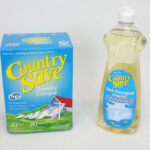With children, there are a plethora of different stains you can end up with on their clothing. I find one of the most common is from fruit juice. We have to spend enough money on new clothes for children, since they grow so quickly. So why throw away money that can be saved with a little elbow grease?
Do not allow the stain to dry or set. Get to it as soon as possible. If the stain dries, rub glycerin on it first.
Fight the urge to go straight for the detergent or soap because those ingredients will set the stain and make it extremely difficult, if not impossible, to remove. Try loosening the stain first with just cold water.
If the stain has been set, use a sponge to dab the stain with white vinegar. Another option is to place a towel beneath the stained item, use an eyedropper to apply some vinegar and tap the vinegar into the material with the back of a spoon. The next step is to work some laundry detergent into the stain.
To remove clear fruit stains such as grapefruit, orange, apple and lemon from washable clothes, first blot the item to remove as much of the stain as you can. Use a sponge to dab the stain with cool water.
Use a sponge to clean the spot with vinegar, then apply a stain pre-treater and launder as usual. If the stain remains, soak the item of clothing in a digestant enzyme solution for at least 15 minutes and wash again. Check your local janitorial supply company for digestant-enzyme solutions.
For dry-clean-only items, sponge on some vinegar and rinse with cool water. If the stain remains, apply a digestant enzyme paste, let sit for about 30 minutes, then rinse. Do not apply digestant enzymes to silk or wool.
To remove red fruit stains, such as cherry, raspberry, blueberry, or grape stains, first remove as much of the stain as you can by blotting and scraping. Blot the stain with a wet sponge until the stain stops bleeding.
If the garment is durable and can be bleached, try rinsing out the stain with boiling water. Position the stain over a bowl or wide-mouthed cup and use a rubber band to hold the fabric in place. Set the bowl in a sink and pour boiling water through the stain. Next treat the stain with lemon juice or an all-purpose cleaner, or make up a solution of equal parts ammonia, water and liquid dishwashing liquid.
For washable cotton or linen items, mix one part vinegar and three parts water and apply to the stain. If the stain remains, soak in a digestant-enzyme solution for an hour, then wash again.
To remove red stains on dry-clean-only fabrics, try using the boiling-water method and lemon juice. Also try sponging the stain with a few drops of vinegar and rinse with cool water.
For cotton and linen, again use one part vinegar and three parts water as a stain remover. If the stain remains, apply a digestant-enzyme paste to the stain and let sit for 30 minutes then rinse. Do not apply digestant if the fabric is silk or wool.




